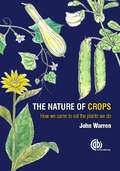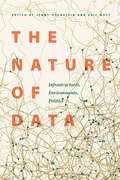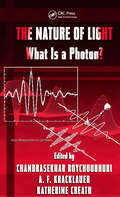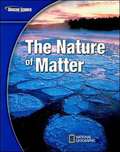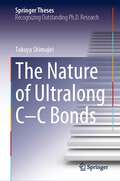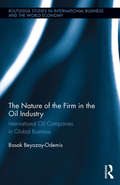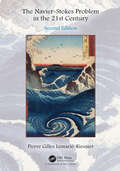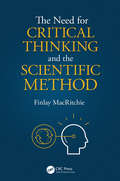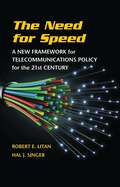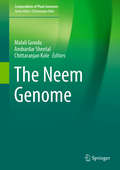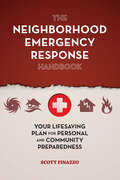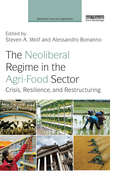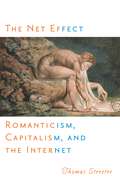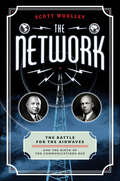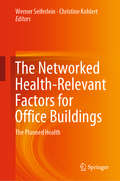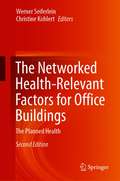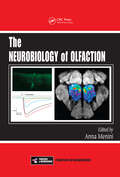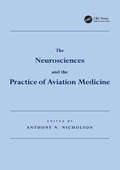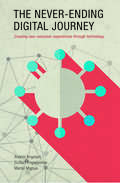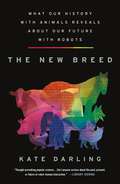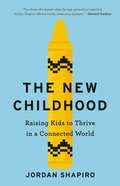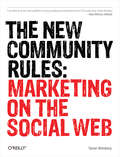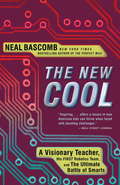- Table View
- List View
The Nature of Crops
by Professor John WarrenHave you ever wondered why we eat wheat, rice, potatoes and cassava? Why we routinely domesticate foodstuffs with the power to kill us, or why we chose almonds over acorns? Answering all these questions and more in a readable and friendly style, this book takes you on a journey through our history with crop plants. Arranged into recurrent themes in plant domestication, this book documents the history and biology of over 50 crops, including cereals, spices, legumes, fruits and cash crops such as chocolate, tobacco and rubber. In The Nature of Crops John Warren reveals: -Why the Egyptians worshipped onions; -Why red-flowering runner beans provide fewer beans than white-flowering; -The inherent dangers of being a pineapple worker; and -Why a bird will always beat you in a chilli pepper eating competition!
The Nature of Data: Infrastructures, Environments, Politics
by Jenny Goldstein Eric NostWhen we look at some of the most pressing issues in environmental politics today, it is hard to avoid data technologies. Big data, artificial intelligence, and data dashboards all promise &“revolutionary&” advances in the speed and scale at which governments, corporations, conservationists, and even individuals can respond to environmental challenges. By bringing together scholars from geography, anthropology, science and technology studies, and ecology, The Nature of Data explores how the digital realm is a significant site in which environmental politics are waged. This collection as a whole makes the argument that we cannot fully understand the current conjuncture in critical, global environmental politics without understanding the role of data platforms, devices, standards, and institutions. In particular, The Nature of Data addresses the contested practices of making and maintaining data infrastructure, the imaginaries produced by data infrastructures, the relations between state and civil society that data infrastructure reworks, and the conditions under which technology can further socio-ecological justice instead of re-entrenching state and capitalist power. This innovative volume presents some of the first research in this new but rapidly growing subfield that addresses the role of data infrastructures in critical environmental politics.
The Nature of Light: What is a Photon? (Optical Science and Engineering)
by AntonioFocusing on the unresolved debate between Newton and Huygens from 300 years ago, The Nature of Light: What is a Photon? discusses the reality behind enigmatic photons. It explores the fundamental issues pertaining to light that still exist today. Gathering contributions from globally recognized specialists in electrodynamics and quantum optics, the book begins by clearly presenting the mainstream view of the nature of light and photons. It then provides a new and challenging scientific epistemology that explains how to overcome the prevailing paradoxes and confusions arising from the accepted definition of a photon as a monochromatic Fourier mode of the vacuum. The book concludes with an array of experiments that demonstrate the innovative thinking needed to examine the wave-particle duality of photons. Looking at photons from both mainstream and out-of-box viewpoints, this volume is sure to inspire the next generation of quantum optics scientists and engineers to go beyond the Copenhagen interpretation and formulate new conceptual ideas about light–matter interactions and substantiate them through inventive applications.
The Nature of Technology: What It Is and How It Evolves
by W. Brian Arthur“More than anything else technology creates our world. It creates our wealth, our economy, our very way of being,” says W. Brian Arthur. Yet despite technology’s irrefutable importance in our daily lives, until now its major questions have gone unanswered. Where do new technologies come from? What constitutes innovation, and how is it achieved? Does technology, like biological life, evolve? In this groundbreaking work, pioneering technology thinker and economist W. Brian Arthur answers these questions and more, setting forth a boldly original way of thinking about technology. The Nature of Technology is an elegant and powerful theory of technology’s origins and evolution. Achieving for the development of technology what Thomas Kuhn’s The Structure of Scientific Revolutions did for scientific progress, Arthur explains how transformative new technologies arise and how innovation really works. Drawing on a wealth of examples, from historical inventions to the high-tech wonders of today, Arthur takes us on a mind-opening journey that will change the way we think about technology and how it structures our lives. The Nature of Technology is a classic for our times.
The Nature of Ultralong C–C Bonds (Springer Theses)
by Takuya ShimajiriThis book focuses on the creation and demonstration of a carbon–carbon (C–C) single bond beyond 1.8 Å and on elucidation of its unique nature. C–C single bond is one of the most fundamental concepts in organic chemistry. The elucidation of its nature is important for further understanding chemical phenomena. The nature in the extreme state of C–C single bond is still unexplored because of the instability of compounds. In terms of its bond length, the limit had been predicted around 1.8 Å based on the experimental and theoretical studies. This book describes a first example of a C–C single bond beyond 1.8 Å by employing the original intramolecular core-shell strategy to make a weak and elongated bond stable enough. The presence of such an elongated bond was demonstrated by experimental and theoretical studies. The bond length changes could affect physical properties such as optical absorption and redox potential. Furthermore, its unique "flexibility" was discovered. This book benefits the chemists with deeper understanding of the covalent bonding.
The Nature of the Firm in the Oil Industry: International Oil Companies in Global Business (Routledge Studies in International Business and the World Economy)
by Basak BeyazayFirm-to-firm relationships, along with the overall structure of industry, have changed markedly over the past decades. Replacing the model of vertical integration with one of global business, firms have started to outsource more by using a wider global network. At the same time, they have begun to increase their control and coordination along the value chain to remain competitive, blurring the boundaries between companies. Understanding the nature of the firm and its role in coordinating the supply chain will help firms to better define global competitive strategies.. The challenges that lie ahead for global business render obsolete the traditional model of procuring each service without long-term supply chain management. Current trends suggest that in the future there will be even deeper supply chain integration in most industries. The Nature of the Firm in the Oil Industry aims to facilitate the understanding of ‘the firm’ via the analysis of the specific relationship between international oil companies, which are among the world’s biggest firms and which act as ‘core system integrators’, and the oil services companies, which help to find, extract, produce and distribute oil along the petroleum industry supply chain. This relationship serves as an example of deep integration by core system integrators and provides insights into the change in the nature of the firm in the era of modern globalization. Aimed at researchers and academics, The Nature of the Firm in the Oil Industry offers a thorough examination of this relationship in an effort to shed light on the nature of the firm, both in the oil industry and in global business today. It is a humble attempt to better understand the firm in a crucial industry.
The Navier-Stokes Problem in the 21st Century
by Pierre Gilles Lemarie-RieussetPraise for the first edition “The author is an outstanding expert in harmonic analysis who has made important contributions. The book contains rigorous proofs of a number of the latest results in the field. I strongly recommend the book to postgraduate students and researchers working on challenging problems of harmonic analysis and mathematical theory of Navier-Stokes equations." —Gregory Seregin, St Hildas College, Oxford University “"This is a great book on the mathematical aspects of the fundamental equations of hydrodynamics, the incompressible Navier-Stokes equations. It covers many important topics and recent results and gives the reader a very good idea about where the theory stands at present.” —Vladimir Sverak, University of Minnesota The complete resolution of the Navier–Stokes equation—one of the Clay Millennium Prize Problems—remains an important open challenge in partial differential equations (PDEs) research despite substantial studies on turbulence and three-dimensional fluids. The Navier–Stokes Problem in the 21st Century, Second Edition continues to provide a self-contained guide to the role of harmonic analysis in the PDEs of fluid mechanics, now revised to include fresh examples, theorems, results, and references that have become relevant since the first edition published in 2016.
The Need for Critical Thinking and the Scientific Method
by Finlay MacRitchieThe book exposes many of the misunderstandings about the scientific method and its application to critical thinking. It argues for a better understanding of the scientific method and for nurturing critical thinking in the community. <P><P>This knowledge helps the reader to analyze issues more objectively, and warns about the dangers of bias and propaganda. The principles are illustrated by considering several issues that are currently being debated. These include anthropogenic global warming (often loosely referred to as climate change), dangers to preservation of the Great Barrier Reef, and the expansion of the gluten-free food market and genetic engineering.
The Need for Speed: A New Framework for Telecommunications Policy for the 21st Century
by Robert E. Litan Hal J. SingerThe twenty-first-century telecommunications landscape is radically different from the one that prevailed as recently as the last decade of the twentieth century. <P><P>Robert Litan and Hal Singer argue that given the speed of innovation in this sector, the Federal Communications Commission's outdated policies and rules are inhibiting investment in the telecom industry, specifically in fast broadband networks. This pithy handbook presents the kind of fundamental rethinking needed to bring communications policy in line with technological advances.Fast broadband has huge societal benefits, enabling all kinds of applications in telemedicine, entertainment, retailing, education, and energy that would have been unthinkable a few years ago. Those benefits would be even greater if the FCC adopted policies that encouraged more broadband providers, especially wireless providers, to make their services available in the roughly half of the country where consumers currently have no choice in wireline providers offering download speeds that satisfy the FCC's current standards.The authors' recommendations include allowing broadband providers to charge for premium delivery services; embracing a rule-of-reason approach to all matters involving vertical arrangements; stripping the FCC of its merger review authority because both the Federal Trade Commission and the Justice Department have the authority to stop anticompetitive mergers; eliminating the FCC's ability to condition spectrum purchases on the identity, business plans, or spectrum holdings of a bidder; and freeing telephone companies from outdated regulations that require them to maintain both a legacy copper network and a modem IP network.These changes and others advanced in this book would greatly enhance consumer welfare with respect to telecommunications services and the applications built around them.
The Neem Genome (Compendium of Plant Genomes)
by Chittaranjan Kole Malali Gowda Ambardar SheetalThis book describes the sequencing efforts for Neem (Azadirachta indica A. Juss), one of the most versatile tropical evergreen tree species. The neem tree is a source of various natural products, including the potent biopesticide azadirachtin and limonoids, which have a broad spectrum of activity against insect pests and microbial pathogens. To identify genes and pathways in neem, three neem genomes and several transcriptomes are studied using next-generation sequencing technologies.Neem has been extensively used in Ayurveda, Unani and homoeopathic medicine and is often referred to as the ‘village pharmacy’ by natives due to its wealth of medicinal properties.Besides the description of the genome, this book discusses the neem microbiome and its role in the production of neem metabolites like salanin, nimbin and exopy-azadirachtin under in vitro conditions. It also highlights cell and tissue culture using various neem explants including the leaf, root, shoot, cambium, etc.
The Neighborhood Emergency Response Handbook: Your Life-Saving Plan for Personal and Community Preparedness
by Scott FinazzoA COMPLETE, STEP-BY-STEP GUIDE TO PREPARING YOURSELF AND YOUR COMMUNITY TO AID FIRST RESPONDERS DURING A DISASTER SITUATION Nothing brings out the best in neighbors more than facing a catastrophe together. But don’t wait till the disaster is upon you. This book shows how you can work together today to protect the lives and homes of all the families in your neighborhood tomorrow. With guidance on how you can take a leadership role, this helpful handbook details everything your community needs to be fully prepared for any natural disaster. * Creating event-specific disaster kits for yourself and your family * Learning about basic fire safety and fire fighting * Establishing triage centers in the event that first responders can’t reach you * Stabilizing disaster victims through need-to-know first aid * Creating your own neighborhood emergency response team to keep your neighborhood safe and save lives should the worst occur
The Neoliberal Regime in the Agri-Food Sector: Crisis, Resilience, and Restructuring (Earthscan Food and Agriculture)
by Alessandro Bonanno Steven A. WolfFor the last three decades, the Neoliberal regime, emphasising economic growth through deregulation, market integration, expansion of the private sector, and contraction of the welfare state has shaped production and consumption processes in agriculture and food. These institutional arrangements emerged from and advanced academic and popular beliefs about the virtues of private, market-based coordination relative to public, state-based problem solving. This book presents an informed, constructive dialogue around the thesis that the Neoliberal mode of governance has reached some institutional and material limits. Is Neoliberalism exhausted? How should we understand crisis applied to Neoliberalism? What are the opportunities and risks linked to the construction of alternatives? The book advances a critical evaluation of the evidence supporting claims of rupture of, or incursions into, the Neoliberal model. It also analyzes pragmatic responses to these critiques including policy initiatives, social mobilization and experimentation at various scales and points of entry. The book surveys and synthesizes a range of sociological frames designed to grapple with the concepts of regimes, systemic crisis and transitions. Contributions include historical analysis, comparative analysis and case studies of food and agriculture from around the globe. These highlight particular aspects of crisis and responses, including the potential for continued resilience, a neo-productivist return, as well as the emergence and scaling up of alternative models.
The Net Effect: Romanticism, Capitalism, and the Internet (Critical Cultural Communication #32)
by Thomas Streeter2012 Honorable Mention from the Association of Internet Researchers for their Annual Best Book Prize Outstanding Academic Title from 2011 by Choice MagazineThis book about America's romance with computer communication looks at the internet, not as harbinger of the future or the next big thing, but as an expression of the times. Streeter demonstrates that our ideas about what connected computers are for have been in constant flux since their invention. In the 1950s they were imagined as the means for fighting nuclear wars, in the 1960s as systems for bringing mathematical certainty to the messy complexity of social life, in the 1970s as countercultural playgrounds, in the 1980s as an icon for what's good about free markets, in the 1990s as a new frontier to be conquered and, by the late 1990s, as the transcendence of markets in an anarchist open source utopia.The Net Effect teases out how culture has influenced the construction of the internet and how the structure of the internet has played a role in cultures of social and political thought. It argues that the internet's real and imagined anarchic qualities are not a product of the technology alone, but of the historical peculiarities of how it emerged and was embraced. Finding several different traditions at work in the development of the internet—most uniquely, romanticism—Streeter demonstrates how the creation of technology is shot through with profoundly cultural forces—with the deep weight of the remembered past, and the pressures of shared passions made articulate.
The Network: The Battle for the Airwaves and the Birth of the Communications Age
by Scott WoolleyThe astonishing story of America’s airwaves, the two friends—one a media mogul, the other a famous inventor—who made them available to us, and the government which figured out how to put a price on air.This is the origin story of the airwaves—the foundational technology of the communications age—as told through the forty-year friendship of an entrepreneurial industrialist and a brilliant inventor.David Sarnoff, the head of RCA and equal parts Steve Jobs, Jack Welch, and William Randolph Hearst, was the greatest supporter of his friend Edwin Armstrong, developer of the first amplifier, the modern radio transmitter, and FM radio. Sarnoff was convinced that Armstrong’s inventions had the power to change the way societies communicated with each other forever. He would become a visionary captain of the media industry, even predicting the advent of the Internet.In the mid-1930s, however, when Armstrong suspected Sarnoff of orchestrating a cadre of government officials to seize control of the FM airwaves, he committed suicide. Sarnoff had a very different view of who his friend’s enemies were.Many corrupt politicians and corporations saw in Armstrong’s inventions the opportunity to commodify our most ubiquitous natural resource—the air. This early alliance between high tech and business set the precedent for countless legal and industrial battles over broadband and licensing bandwidth, many of which continue to influence policy and debate today.
The Networked Health-Relevant Factors for Office Buildings: The Planned Health
by Werner Seiferlein Christine KohlertPeople who work in an office spend at least a third of their lifetime in these spaces. The planning of office and administration buildings can therefore contribute a great deal to the satisfaction and well-being of future users. The book looks at the health-relevant factors that affect people in office and administration buildings and therefore deserve special attention in the planning process. In doing so, the authors are guided by a concept of health as defined by the World Health Organization: Accordingly, health encompasses mental as well as social and physical well-being and thus goes far beyond the factors laid down in legal norms and guidelines. In this volume, architects and designers, physicians and ergonomists deal with all aspects of interior design seen from a health perspective: What role does colour design play, what significance do light, air and noise have? What does a demand-oriented building technology look like and how is the office furniture adequately designed? Which medical and hygienic aspects have to be considered? How can offices be designed in terms of work-life balance and how will the office change in the course of digitalisation? The book serves as a guideline that can be applied chapter by chapter in the planning of health-promoting office spaces - depending on the interests of the reader. Problems that arise are discussed using examples, and checklists help you with planning and implementation. The guide is aimed at building owners, architects, engineers, but also at lawyers, psychologists and doctors as well as university members in the field of economics and engineering.
The Networked Health-Relevant Factors for Office Buildings: The Planned Health
by Werner Seiferlein Christine KohlertPeople who work in an office spend at least a third of their lifetime in these spaces. The planning of office and administration buildings can therefore contribute a great deal to the satisfaction and well-being of future users. The book looks at the health-relevant factors that affect people in office and administration buildings and therefore deserve special attention in the planning process. In doing so, the authors are guided by a concept of health as defined by the World Health Organization: Accordingly, health encompasses mental as well as social and physical well-being and thus goes far beyond the factors laid down in legal norms and guidelines. In this volume, architects and designers, physicians and ergonomists deal with all aspects of interior design seen from a health perspective: What role does colour design play, what significance do light, air and noise have? What does a demand-oriented building technology look like and how is the office furniture adequately designed? Which medical and hygienic aspects have to be considered? How can offices be designed in terms of work-life balance and how will the office change in the course of digitalisation? The book serves as a guideline that can be applied chapter by chapter in the planning of health-promoting office spaces - depending on the interests of the reader. Problems that arise are discussed using examples, and checklists help you with planning and implementation. The guide is aimed at building owners, architects, engineers, but also at lawyers, psychologists and doctors as well as university members in the field of economics and engineering.
The Neurobiology of Olfaction (Frontiers in Neuroscience)
by Anna MeniniComprehensive Overview of Advances in OlfactionThe common belief is that human smell perception is much reduced compared with other mammals, so that whatever abilities are uncovered and investigated in animal research would have little significance for humans. However, new evidence from a variety of sources indicates this traditional view is likely
The Neurosciences and the Practice of Aviation Medicine
by Anthony N. NicholsonThis book brings the neurosciences to operational and clinical aviation medicine. It is concerned with the physiology and pathology of circadian rhythmicity, orientation, hypotension and hypoxia, and with disorders of the central nervous system relevant to the practice of aviation medicine. The chapters on circadian rhythmicity and orientation deal with the impaired alertness and sleep disturbance associated with desynchrony and with the effects of linear and angular accelerations on spatial awareness. Hypotension and hypoxia cover cerebral function during increased gravitational stress, clinical aspects of exposure to acute hypoxia, the mild hypoxia of the cabin of transport aircraft, adaptation and acclimatization to altitude and decompression at extreme altitudes and in space. Disorders of particular significance to the practice of aviation medicine such as excessive daytime sleepiness, epilepsy, syncope, hypoglycaemia, headache and traumatic brain injury are covered, while neuro-ophthalmology, the vestibular system and hearing also receive detailed attention. The potentially adverse effects of the aviation environment and of disorders of the nervous system are brought together, and the text covers the neurological examination as it relates to aircrew and explores current management and therapeutics. The Neurosciences and the Practice of Aviation Medicine is an essential work for those involved in the practice of aviation medicine where familiarity with the effects of the aviation environment on the nervous system and understanding the pathophysiology of relevant clinical disorders are of prime concern. The authors from leading centres of excellence are physiologists concerned with the aviation environment and physicians involved in the day-to-day practice of medicine. They bring to this authoritative text wide experience and expertise in both the experimental and clinical neurosciences.
The Never-Ending Digital Journey: Creating new consumer experiences through technology
by Andrés Angelani Guibert Englebienne Martín MigoyaThe Never-Ending Digital Journey provides readers with the concepts and steps needed to create successful user experiences. The authors look ahead and explore digital scenarios of the future. They probe how technology is changing the way users interact with brands, and they address today’s digital challenges with new ways of surprising consumers, integrating design and engineering. <P><P> The authors leverage knowledge gleaned from working with renowned global companies to describe the recipe needed to build a Digital Journey. With a strong focus on Agile Pods, they dive into technolo- gies, processes, team building, motivation, and met- rics that enable businesses to construct and nurture the dynamic ecosystems necessary in this digital era to foster success.
The New Breed: What Our History with Animals Reveals about Our Future with Robots
by Kate DarlingFor readers of The Second Machine Age or The Soul of an Octopus, a bold, exciting exploration of how building diverse kinds of relationships with robots—inspired by how we interact with animals—could be the key to making our future with robotic technology work.There has been a lot of ink devoted to discussions of how robots will replace us and take our jobs. But MIT Media Lab researcher and technology policy expert Kate Darling argues just the opposite, and that treating robots with a bit of humanity, more like the way we treat animals, will actually serve us better. From a social, legal, and ethical perspective, she shows that our current ways of thinking don’t leave room for the robot technology that is soon to become part of our everyday routines. Robots are likely to supplement—rather than replace—our own skills and relationships. So if we consider our history of incorporating animals into our work, transportation, military, and even families, we actually have a solid basis for how to contend with this future. A deeply original analysis of our technological future and the ethical dilemmas that await us, The New Breed explains how the treatment of machines can reveal a new understanding of our own history, our own systems and how we relate—not just to non-humans, but also to each other.
The New Cambridge History of India IV.4: An Agrarian History of South Asia
by David LuddenOriginally published in 1999, David Ludden's book offers a comprehensive historical framework for understanding the regional diversity of agrarian South Asia. Adopting a long-term view of history, it treats South Asia not as a single civilization territory, but rather as a patchwork of agrarian regions, each with their own social, cultural and political histories. The discussion begins during the first millennium, when farming communities displaced pastoral and tribal groups, and goes on to consider the development of territoriality from the sixteenth to the nineteenth centuries. Subsequent chapters consider the emergence of agrarian capitalism in village societies under the British, and demonstrate how economic development in contemporary South Asia continues to reflect the influence of agrarian localism. As a comparative synthesis of the literature on agrarian regimes in South Asia, the book promises to be a valuable resource for students of agrarian and regional history as well as of comparative world history.
The New Childhood: Raising Kids to Thrive in a Connected World
by Jordan ShapiroA provocative look at the new, digital landscape of childhood and how to navigate it.In The New Childhood, Jordan Shapiro provides a hopeful counterpoint to the fearful hand-wringing that has come to define our narrative around children and technology. Drawing on groundbreaking research in economics, psychology, philosophy, and education, The New Childhood shows how technology is guiding humanity toward a bright future in which our children will be able to create new, better models of global citizenship, connection, and community.Shapiro offers concrete, practical advice on how to parent and educate children effectively in a connected world, and provides tools and techniques for using technology to engage with kids and help them learn and grow. He compares this moment in time to other great technological revolutions in humanity's past and presents entertaining micro-histories of cultural fixtures: the sandbox, finger painting, the family dinner, and more. But most importantly, The New Childhood paints a timely, inspiring and positive picture of today's children, recognizing that they are poised to create a progressive, diverse, meaningful, and hyper-connected world that today's adults can only barely imagine.
The New Community Rules: Marketing on the Social Web
by Tamar WeinbergBlogs, networking sites, and other examples of the social web provide businesses with a largely untapped marketing channel for products and services. But how do you take advantage of them? With The New Community Rules, you'll understand how social web technologies work, and learn the most practical and effective ways to reach people who frequent these sites. Written by an expert in social media and viral marketing, this book cuts through the hype and jargon to give you intelligent advice and strategies for positioning your business on the social web, with case studies that show how other companies have used this approach. The New Community Rules will help you:Explore blogging and microblogging, and find out how to use applications such as Twitter to create brand awarenessLearn the art of conversation marketing, and how social media thrives on honesty and transparencyManage and enhance your online reputation through the social webTap into the increasingly influential video and podcasting marketDiscover which tactics work -- and which don't -- by learning about what other marketers have triedMany consumers today use the Web as a voice. The New Community Rules demonstrates how you can join the conversation, contribute to the community, and bring people to your product or service.
The New Cool: A Visionary Teacher, His First Robotics Team, and the Ultimate Battle of Smarts
by Neal BascombThat Monday afternoon, in high-school gyms across America, kids were battling for the only glory American culture seems to want to dispense to the young these days: sports glory. But at Dos Pueblos High School in Goleta, California, in a gear-cluttered classroom, a different type of "cool" was brewing. A physics teacher with a dream - the first public high-school teacher ever to win a MacArthur Genius Award -- had rounded up a band of high-I.Q. students who wanted to put their technical know-how to work. If you asked these brainiacs what the stakes were that first week of their project, they'd have told you it was all about winning a robotics competition - building the ultimate robot and prevailing in a machine-to-machine contest in front of 25,000 screaming fans at Atlanta's Georgia Dome. But for their mentor, Amir Abo-Shaeer, much more hung in the balance. The fact was, Amir had in mind a different vision for education, one based not on rote learning -- on absorbing facts and figures -- but on active creation. In his mind's eye, he saw an even more robust academy within Dos Pueblos that would make science, technology, engineering, and math (STEM) cool again, and he knew he was poised on the edge of making that dream a reality. All he needed to get the necessary funding was one flashy win - a triumph that would firmly put his Engineering Academy at Dos Pueblos on the map. He imagined that one day there would be a nation filled with such academies, and a new popular veneration for STEM - a "new cool" - that would return America to its former innovative glory. It was a dream shared by Dean Kamen, a modern-day inventing wizard - often-called "the Edison of his time" - who'd concocted the very same FIRST Robotics Competition that had lured the kids at Dos Pueblos. Kamen had created FIRST (For Inspiration and Recognition of Science and Technology) nearly twenty years prior. And now, with a participant alumni base approaching a million strong, he felt that awareness was about to hit critical mass. But before the Dos Pueblos D'Penguineers could do their part in bringing a new cool to America, they'd have to vanquish an intimidating lineup of "super-teams"- high-school technology goliaths that hailed from engineering hot spots such as Silicon Valley, Massachusetts' Route 128 technology corridor, and Michigan's auto-design belt. Some of these teams were so good that winning wasn't just hoped for every year, it was expected. In The New Cool, Neal Bascomb manages to make even those who know little about - or are vaguely suspicious of - technology care passionately about a team of kids questing after a different kind of glory. In these kids' heartaches and headaches - and yes, high-five triumphs -- we glimpse the path not just to a new way of educating our youth but of honoring the crucial skills a society needs to prosper. A new cool.From the Hardcover edition.
